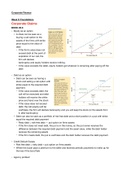Corporate Finance
Week 0: Foundations
Corporate Claims
BOOK 20.6
- Equity as an option
• A share can be seen as a
buying a call option to the
assets of the rms with strike
price equal to the value of
debt
- If the rm’s value does not
exceed debt at the point of
expiration of our call, the
rm will declare
bankruptcy and equity holders receive nothing.
- If the value exceeds the debit, equity holders get whatever is remaining after paying o the
debt
- Debt as an option
• Debt can be seen as having a
stock and selling a call option with
strike equal to the required debt
payment.
- If the value exceeds debt, the
call will be exercised and debt
holders will receive the strike
price and hand over the stock
- If the value does not exceed
debt, the call (equity) will be
worthless, the rm will declare bankruptcy and you will keep the stock (or the assets from
it, after bankruptcy)
• Debt can also be seen as a portfolio of risk free debt and a short position in a put with strike
equal the required debt payment
- Risky debt = risk-free debt — put option on rms assets
- If the rm does not meet debt, the put is in the money, so the put owner receives the
di erence between the required debt payment and the asset value, while the debt holder
receives the remaining assets
- If the rm meets debt, the put is worthless and the debt holder receives the debt payment.
- Credit Default Swaps
• Risk free debt = risky debt + put option on rms assets
• Where the buyer pays a premium to the seller and receives periodic payments to make up for
the loss if the bond fails
- Agency problem
fi ff fi fifi fifi ff
, • Looking at debt and equity as options allows for new interpretation
• Options increase in price with volatility, and if equity is a call option on the rms’ assets, then
equity holders will like increased volatility
• On the other hand, debt holders are short on a put option, meaning the increase in price will
not be bene cial for them
• This is known as the asset substitution problem
SLIDES
- Capital structure is the sum of total claims on the assets of the rm
• Equity holders own the corporation after all other claims have been satis ed
- Capital structure determines how cash ow rights are allocated
• Basically determine the payout
• Payo diagrams plots payo s as a
function of the underlying rm value
at the time
• Equity is like a call option on the
companies assets, and holds
control rights
• Bonds have a speci c payment and
nothing after that, they have no
control rights except for bond
covenants
• Non nancial liabilities include:
Payables, credit, leases, tax
obligations
Arbitrage
Book (3.4-3.5)
- Arbitrage: the practice of buying and selling equivalent goods in di erent markets to take
advantage of a price di erence
• Equivalent —> generating the same payo s
- Law of one price
• In a normal market, the price of equivalent assets will be the same everywhere, as any
di erence will cause investors to scramble for pro ts, equaling the price
- No-arbitrage is the point where there is no arbitrage on the market, as equivalent assets all sell
at the same price
- The separation principle states that transactions neither create nor destroy value in their own.
Therefore, we can evaluate NPV of an investment separately from the transaction the rm is
considering. This means that we should separate investment decisions from nancing choice
Slides (Nice example on slides 0-2)
- The law of one price is the key concept in nance, it is used by MM and for valuation
- Arbitrage can never exist, as someone will take immediate advantage of it to bring it back to its
fair price
ff fiff fi fi ff fi ff fl fffi fi fi ff fi fi fi fi
, - Two assumptions for valuation/pricing
• Two securities that generate the same payo must cost the same
Options (ch 20.1-.3, 20.6)
Book
Slides
- Corporate claims can be interpreted as portfolios of options
- Options: contract that gives owner the right (but not the obligation) to purchase/sell an asset at
an agreed price in the future
• European options can only be exercised at expiration, while American options can be
exercised whenever before the date
- Payo of a call option is maximum ( Stock price - Strike price, 0)
• It can never be negative
- Payo of a put option (Strike price - stock price, 0)
- Put-call parity
• The two portfolios will have the same
payo at maturity
- Stock + put = call + risk free bond
• In proper notation
- S + P = C + PV(K)
• Where K is the face value of the
bond, and also the strike of the
call and the put
- Capital structure determines how
cash ows are split between di erent
investors
Week 1: Modigliani-Miller
Slides
Modigliani-Miller (ch 14.1-.3)
MM Proposition 1: under perfect markets, the value of the rm is not a ected by its capital
structure. The value of the rm is equal to the total cash ows generated by its assets.
MM Proposition 2: weighted-average return from debt and equity is equal to the return on
unlevered equity
- The cost of capital of levered equity increases with the rms market value debt-equity ratio
- Levered equity = unlevered + (D/E) * (unlevered - cost of debt)
- The return on unlevered equity will be the same regardless of the capital structure of the rm
- To calculate the return of unlevered equity
flff fi ff ff fifl fi ff fi






